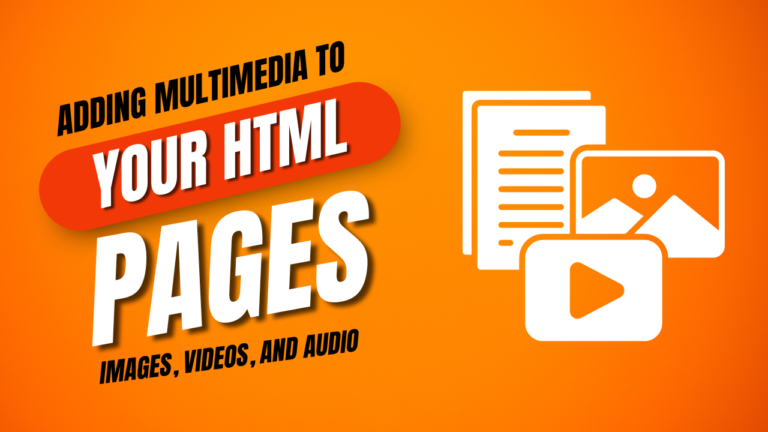How to Properly Structure an HTML Document
Creating a well-structured HTML document is essential for developing clean, readable, and maintainable code. Proper structure ensures that your web pages are both user-friendly and search engine optimized, making it easier for browsers and search engines to understand your content. In this guide, I’ll walk you through the steps to properly structure an HTML document, using a basic e-commerce product page as an example.
Introduction
When structuring an HTML document, certain elements must be included to create a functional and accessible web page. These elements include the <!DOCTYPE html> declaration, the <html> element, the <head> section, and the <body> section. This guide will cover:
- Setting up the HTML Document with
<!DOCTYPE html>and<html> - Adding Metadata and Links in the
<head>Section - Structuring the Content in the
<body>Section - Using Semantic HTML Elements like
<header>,<main>,<section>, and<footer> - Example: Structuring a Basic E-commerce Product Page
By the end of this tutorial, you’ll know how to structure any HTML document properly, ensuring that it is optimized for both readability and performance.
Setting Up the HTML Document with <!DOCTYPE html> and <html>
Every HTML document begins with a <!DOCTYPE html> declaration. This tells the browser that the document is written in HTML5, the latest version of HTML. After this declaration, the entire document is wrapped in an <html> tag.
<!DOCTYPE html> <html lang="en">
Step 2: Adding Metadata and Links in the <head> Section
The <head> section of your HTML document contains metadata about the page, links to stylesheets, scripts, and the title of the web page. This is where you define the character encoding, viewport settings, and any external resources like CSS files.
<head>
<meta charset="UTF-8">
<meta name="viewport" content="width=device-width, initial-scale=1.0">
<title>Product Page - Online Store</title>
<link rel="stylesheet" href="styles.css">
</head>
Step 3: Structuring the Content in the <body> Section
The <body> section contains all the visible content of the web page. This is where you’ll place your headers, navigation, main content, and footers. The content should be well-organized using appropriate HTML elements.
<body>
<header>
<h1>Welcome to Our Online Store</h1>
<nav>
<ul>
<li><a href="index.html">Home</a></li>
<li><a href="products.html">Products</a></li>
<li><a href="contact.html">Contact Us</a></li>
</ul>
</nav>
</header>
Step 4: Using Semantic HTML Elements like <header>, <main>, <section>, and <footer>
Using semantic HTML elements helps to organize your content logically and makes it easier for search engines to understand the structure of your page. For instance, you can use <header> for the top section of the page, <main> for the main content, <section> to group related content, and <footer> for the footer section.
<main>
<section>
<h2>Featured Product</h2>
<article>
<h3>Product Name</h3>
<p>Description of the product goes here. This product is the best in its category and offers great value.</p>
<p>Price: $49.99</p>
<a href="purchase.html">Buy Now</a>
</article>
</section>
</main>
<footer>
<p>© 2024 Online Store. All rights reserved.</p>
</footer>
</body>
</html>
Example: Structuring a Basic E-commerce Product Page
Let’s put everything together. Here’s the full HTML code for a basic e-commerce product page:
<!DOCTYPE html>
<html lang="en">
<head>
<meta charset="UTF-8">
<meta name="viewport" content="width=device-width, initial-scale=1.0">
<title>Product Page - Online Store</title>
<link rel="stylesheet" href="styles.css">
</head>
<body>
<header>
<h1>Welcome to Our Online Store</h1>
<nav>
<ul>
<li><a href="index.html">Home</a></li>
<li><a href="products.html">Products</a></li>
<li><a href="contact.html">Contact Us</a></li>
</ul>
</nav>
</header>
<main>
<section>
<h2>Featured Product</h2>
<article>
<h3>Product Name</h3>
<p>Description of the product goes here. This product is the best in its category and offers great value.</p>
<p>Price: $49.99</p>
<a href="purchase.html">Buy Now</a>
</article>
</section>
</main>
<footer>
<p>© 2024 Online Store. All rights reserved.</p>
</footer>
</body>
</html>
This example shows how to properly structure a basic e-commerce product page, ensuring that your HTML document is well-organized and optimized for both readability and SEO.
Conclusion
Understanding how to properly structure an HTML document is fundamental to web development. By following these steps, you can create well-organized, SEO-friendly web pages that are easy to maintain and expand upon. Whether you’re building a simple portfolio or a complex e-commerce site, mastering the basics of HTML structure is key to success.






